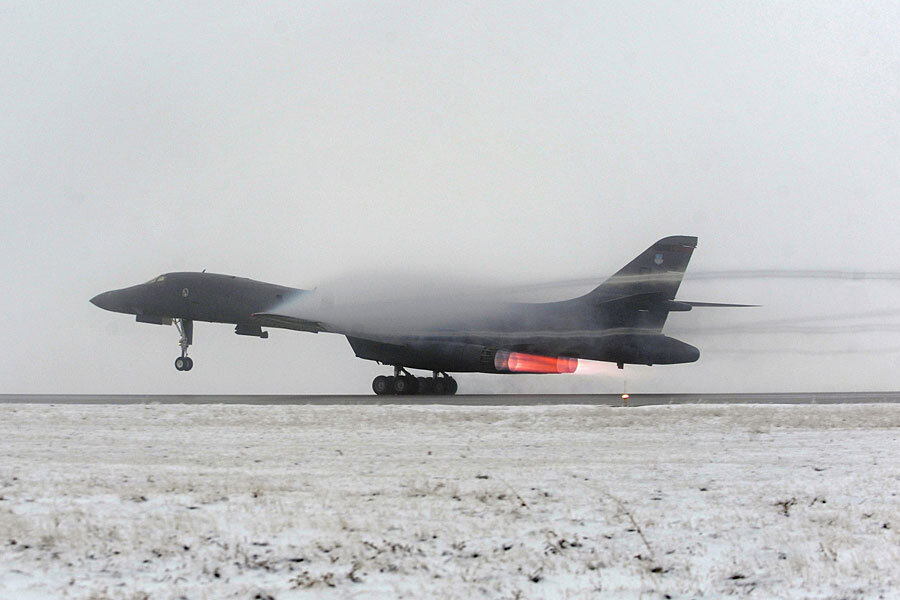Why the United States might send bombers to Australia
Loading...
Pentagon officials said on Wednesday that the United States is considering stationing B-1 and B-52 bombers in Australia in the face of rising tensions in the South China Sea.
China’s expansion to both natural and man-made islands in those waters, including its decision to build air strips and install surface-to-air missile batteries, has prompted Washington to look at a number of options, both diplomatic and military.
The US-Australia collaboration is representative of America's continued interest in maintaining stability in the region by counterbalancing China’s military buildup, say analysts.
“It is part of an overall rebalancing of military forces to the region,” says Dr. Michael Auslin of the American Enterprise Institute, in a phone interview with The Christian Science Monitor.
China’s militarization of the South China Sea recently prompted the US to conduct what it called a routine patrol of the region with the USS John C. Stennis, an aircraft carrier, as well as one cruiser and two destroyers.
For more than six decades, Australia, the US, and New Zealand have had a security alliance. But in 2011, Australia agreed to a US troop deployment on Australian soil, rising to 2,500 by 2017.
Although Australia is not doing much to oppose China’s expansion itself, Dr. Auslin says the country is a very important regional ally for the US. Nevertheless, Australia is wary of escalating tensions with China due to the robust trade between the two nations. “Australia is not looking to rupture relations with China,” says Auslin, “and it is therefore balancing security concerns with economic opportunities.”
About 60 percent of Australia’s trade passes through the South China Sea. China is Australia’s biggest trade partner.
Does Wednesday’s announcement indicate a greater willingness on the part of the Australian government to engage with China?
Auslin suggests that the plan would be a step in that direction for Australia and other countries in the region. There are several countries which have rival claims on the South China Sea islands that have not yet engaged with China.
If tensions continue to escalate, other countries may join with the United States to conduct joint naval patrols, including Australia.
Jennifer Harris, a senior fellow at the Council on Foreign Relations and author of a forthcoming book on China’s rise, says in an e-mail that stationing US bombers in Australia would pass the responsibility of lowering tensions to China.
"Having signaled clearly to Beijing what further escalation by China (of precisely the sort we’ve seen in recent weeks) would bring," Harris says, "the US military is simply making good on those promises – leaving the gas and brake pedals firmly in China’s hands."
China’s economic situation could also influence other countries in their decision to make a stand against China. “The Chinese economic slowdown may change some countries calculations of how dependent they are on China,” says Auslin, “and they may be more willing to act.”
The tensions already appear to have impacted Australia’s military planning. In February, Australian Prime Minister Malcolm Turnbull revealed a 10-year, $140 million military expansion plan that would strengthen the country’s relationship with the United States.
In defense of the plan, Mr. Turnbull spoke to the importance of freedom of the seas to an island nation like Australia. “We operate in a region where sea lanes, freedom of access to navigation,” said Turnbull, “where maritime assets in a naval sense are growing, both submarine and surface vessels.”
Washington also says it wants to preserve freedom of navigation in the South China Sea: About $5.3 trillion in trade passes through the South China Sea – and the US is a beneficiary of much of that trade.
What are China's motives for moving into the South China Sea?
"This conflict is really a testing ground for Beijing. China’s leadership is looking for a fresh way of measuring its own strength against the US alliance system in Asia," said Dr. Harris. "The situation in the East and South China Sea is far newer, and less encumbered with historical baggage and tacit understandings formed when China’s hand was far weaker than it is now."
Russia is another factor that could have spurred the United States’ decision to send bombers to Australia.
The Asian giant has been sending its planes on long flights over the Pacific, says US Air Force Gen. Lori Robinson, commander of US Pacific Air Forces. “We have seen Russian long-range aviation come through the Pacific, circumnavigating Japan and circumnavigating Guam,” she told The Wall Street Journal.
Though such flights may well be making the US nervous, however, General Robinson added that it is well within Russia’s rights to fly in international airspace.
Meanwhile, the US bombers and their crews would rotate through two existing bases in northern Australia, at Tindal and Darwin. Although discussions are ongoing and nothing is settled, Australia's prime minister indicated that collaboration with US military forces is essential to balancing the competing regional forces.
“We reject the harsh and cynical assessment that might is right and justice can be found only between equals in power,” said Turnbull in February, “But equally we know that a strong Australia is essential to enable us to play our part in providing the measured balance upon which regional security depends.”






